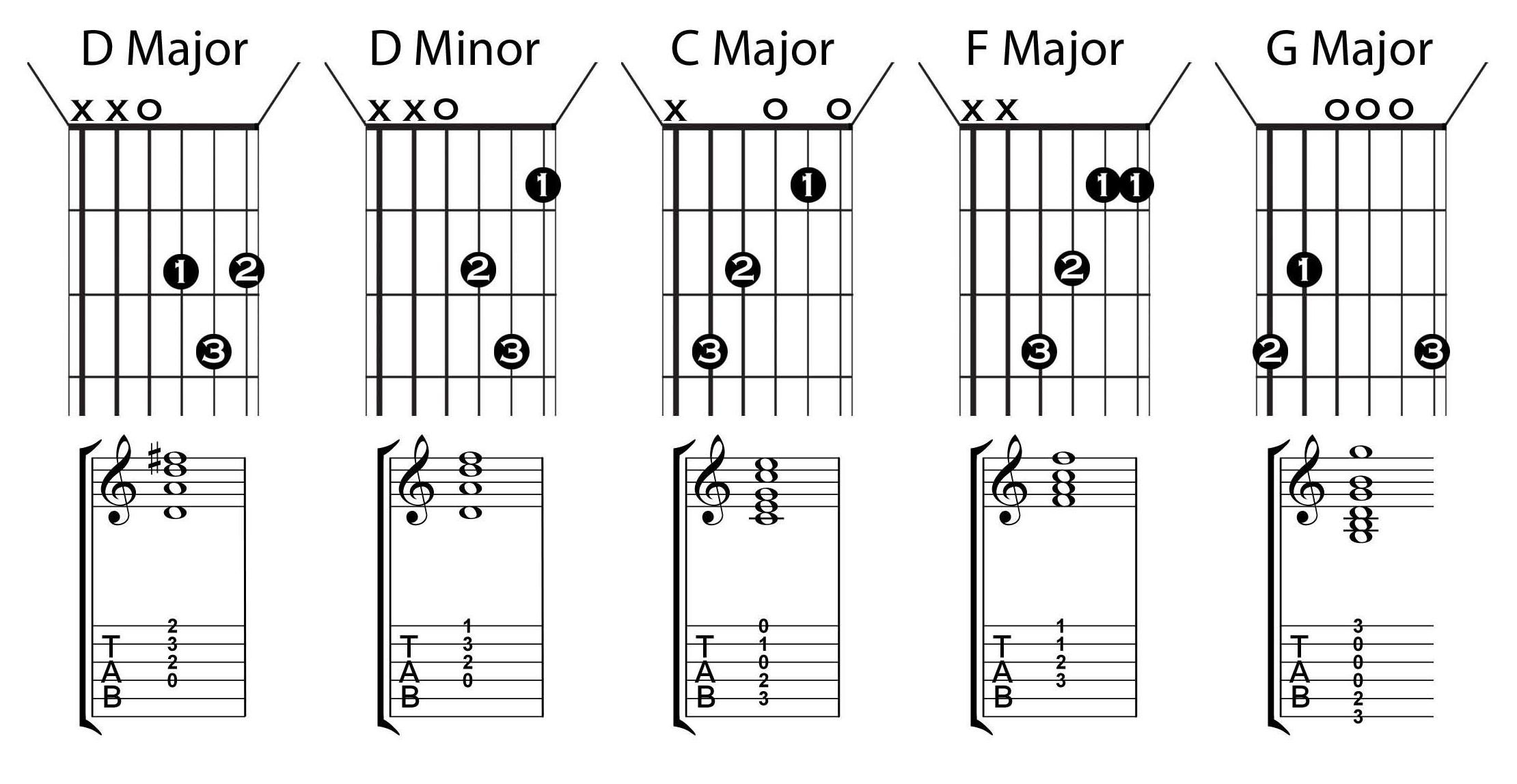How to Change Guitar Chords Faster
Wondering how to change guitar chords faster? You’ve come to the right place. The following is a list of some tried and true tricks for turbo-boosting your triads. Remember, The letter by itself (E) indicates a Major chord while a small “m” after the note name (Em) indicates a minor chord.
1) Memorize the Chords – To be able to play fast chord changes your fingers must know where to go automatically! The first step to playing quicker changes is eliminating any hesitation mentally. By learning and memorizing these nine basic open chords below, you will be able to play literally thousands of songs.

You will know you have the chords memorized when you can visualize the chord shapes in your mind. At night, when you are going to bed, mentally picture the your fingers playing each individual chord and visualize what string and fret each finger is on. Better than counting sheep!
2) Practice playing the chords cleanly – Strum each chord (make sure you are always strumming from the correct string) and make sure you aren’t getting any buzzing. “Arpeggiate” (pluck each string individually) through the chord and make sure your fingers aren’t muting any of the other strings.
3) Chord planting exercise – A great exercise for beginners. Form a chord and then lift all of the fingers off of the strings ever so slightly and then put them back down on the chord shape. Start by lifting very lightly and then progress to a little farther off of the strings. Make sure you are landing directly on the tips of the fingers near the fingernail. This is a great tip to help you change guitar chords faster.

4) Use the same fingering –This is very important at first for increasing the speed of your chord changes. Make sure every time you play a certain chord you are using the exact same fingering. It is crucial to stay consistent because any inconsistencies will introduce hesitation, which will slow you down. Eventually you can experiment with other fingerings depending on the other chords you are transitioning to.
5) Transition back and forth between each chord change – Practice changing between every possible chord change strumming each chord once. Start slow and try to move all of the fingers at the same time. Stay relaxed and loose and gradually speed up. Go in this order, which starts with the easier changes and progresses to the harder ones.
E <-> Em, E <-> Am, Em <-> A, A <-> D, Am <-> Dm, C <-> F.
6) Use pivot fingers – Don’t lift any fingers you don’t need to. Be efficient! For example, when changing E to Em, keep the 2nd and 3rd fingers planted. From C to F keep the 1st finger down, A to Dm and F to Dm keep the 2nd finger down, C to Am keep the 1st and 2nd fingers planted as you move the 3rd. For E to D, keep the 1st finger on the 3rd string and slide it between the first fret (E) and second fret (D).
7) Press lightly and relax – ultimately you want to be pressing just hard enough to get a clear tone. Pressing too hard with a kung fu grip will introduce unwanted tension and slow you down and potentially bend the strings out of tune. Also, make sure your fingers are right up against the frets to avoid getting buzzing.
8) Reverse the order of the fingers – this is a great trick for getting all of the fingers to move and come down at the same time, which is essential for faster chord changes. G to C is a great progression to do this on. If when switching from G to C your fingers are landing on the frets in this order: 1st, 2nd, 3rd; then lead the chord change with the finger that is coming down last (the 3rd). In other words, put the 3rd finger down first when going to C to train that finger to know where exactly to go. You can do the same going back to G as well. After practicing this technique for a bit you will notice that the fingers start to gradually land together.
9) Program the muscle memory – all of these tricks and techniques are tools for programming the muscle memory in the fingers so they change automatically. There’s no real shortcut to doing the reps… it will take time but the more you practice the quicker you will be able to change chords faster!
I would not recommend using the lift up method (well, most of the time) – What this means is that a lot of guitarists cheat and lift the fingers off of the strings on the last strum to get a jump start on getting to the next chord. The result is you hear the strummed open strings on the last stroke, which can sound very sloppy. I would recommend NOT doing this unless you are playing a super fast tempo and have to. LEARN THE RIGHT WAY! It might take a little more time to do it right but you’ll be glad you did in the long run. Any musician (or athlete, or anyone for that matter) who constantly takes short cuts ends up being a “hack” (in the not-so-good sense of the word) in their field. Follow these tips to help you change guitar chords faster!
Click here for more information on guitar lessons with Mark Hamrock.
Check out Hamrock Music’s YouTube Channel for video lessons for learning guitar, bass guitar, music theory, songwriting, composing, and music production.

